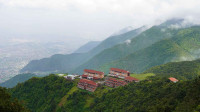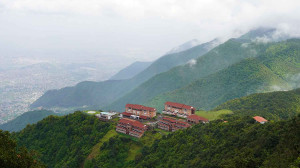Money
With disruptions to supply chains and public movement, inflation was only to be expected
Despite the government’s assurances to keep prices steady and supplies flowing, markets have reported a steady rise in prices ever since the lockdown was instituted.%20(2).jpg&w=900&height=601)
Sangam Prasain
Nepal's stay-at-home order became stricter on Friday but an unemployed Ishwor Marasini faces a new problem—inflation.
The 37-year-old from Raniban runs a stationery shop, which has been closed for four weeks since the lockdown, and without a steady source of income, he is worried about how long he’ll be able to pay the rising prices for food and other essentials.
A few weeks ago, sugar cost Rs70 per kg but it has now climbed to Rs 85, he said. The prices of lentils have increased by Rs25-30 per kg and rice by Rs200 per sack. Edible oil prices increased Rs20 on Friday.
"Everything is expensive. I can’t even get three vegetables for Rs500," said Marasini.
The government has been assuring the public that prices will not rise due to the lockdown, but from potato to sugar and eggs to mutton, prices are increasing steadily.
Prices started rising in the third week of March, when the lockdown was first instituted. The government’s sudden announcement of the lockdown on March 23 sparked panic buying, clearing stocks. New consignments soon entered the market but at higher rates.
With almost all economic activities curtailed, factories closed and all public movement prohibited, prices have been steadily increasing, despite all government assurances.
The government’s target this year was to tame consumer price inflation at a maximum of 6 percent, but the average inflation had already reached 6.87 percent in mid-February, compared to 4.35 percent the same period last year, according to Nepal Rastra Bank's macroeconomics indicator.
But the breakdown in supply chains and travel restrictions keeping farmers at home could result in a year of hyperinflation—when prices increase rapidly and go out of control—warn economists.
The lockdown has meant that fewer goods are getting to the market and stocks at grocery stores and small retail shops are depleting. Farmers are not harvesting new crops and even when harvested, they are not reaching the mass market.
"Inflationary pressures will remain elevated and upward of 6.5 percent for this and the next fiscal years,” said economist Chandan Sapkota. “This is due to both cost-push inflation. The winter agricultural harvest has been affected due to physical distancing and a lack of workers."
Cost-push inflation is when prices increase overall due to increases in the cost of wages and raw materials.
Globally, food security and inflation concerns have grown with the threat of Covid-19, with some governments contemplating restricting the flow of staple food out of their countries.
In Russia, the vegetable oils union has called for a restriction on sunflower seed exports, and Kazakhstan has suspended exports of goods such as buckwheat, sugar, and sunflower oil until the middle of next month. Top rice producing countries like India and Vietnam have also restricted exports.
As the Covid-19 pandemic penetrates more deeply into global supply chains, prices for key staples are starting to soar in many parts of the world.
Nepal, which depends heavily on imports, may feel a much larger impact, said economists.
During crises, there is always a gap between demand and supply, which naturally leads to inflation, said Ram Sharan Mahat, a former finance minister.
"We have asked the government to make the lockdown a bit more flexible. Putting everyone indoors is not a solution. There should be some economic activities to prevent a financial crisis," said Mahat. “As this is the peak time for agricultural activities, urban workers who want to go home can be mobilised in the agriculture sector to ensure production and prevent a food crisis."
Food prices are also likely to remain high because of a likely shortage of agricultural input, particularly chemical fertiliser which is imported, said Sapkota.
"The negative effect from these will more than offset the potential gains from a normal monsoon. So food price pressures will be high," he said.
While lower fuel prices will provide some succor, they won't be enough to counterbalance the increase in prices of imported goods, said Sapkota.
"The domestic firms themselves will take time to restart production, which may remain below the usual capacity. A combination of these events will increase demand for non-food goods and services after the lockdown is over and is going to put additional pressure on prices."
Economists, however, believe that the rise in prices is largely being driven by unscrupulous actors, as lower fuel prices and a steady supply of imports ensured by the government should have kept prices stable.
According to Mahat, it's due to the lack of a proper distribution channel.
"Some opportunists are taking advantage of the crisis," he said.
Devendra Bhakta Shrestha, president at Nepal Wholesalers’ Association, admitted prices are on the higher side due to current logistical constraints.
"Supply is normal but transporters are charging double fares as vehicles are returning empty after unloading goods," said Shrestha. “Labourers who were charging Rs2 per kg have also hiked their rates to Rs5 due to the shortage of workers. These burdens are added to the consumers’ bill.”
But Shrestha charged retailers with also exploiting the crisis and keeping profit margins of 10 to 20 percent for themselves.
The outlook for the near future is not pleasing, say economists. When stay-at-home restrictions are lifted, demand will roar back but supply constraints will remain.
"The recovery in demand will be much faster than the recovery in supply,” said Mahat. “As it will take some time for supply chains to be resolved, commodity prices will continue to rise.”
Krishana Prasain contributed reporting.




 9.68°C Kathmandu
9.68°C Kathmandu















